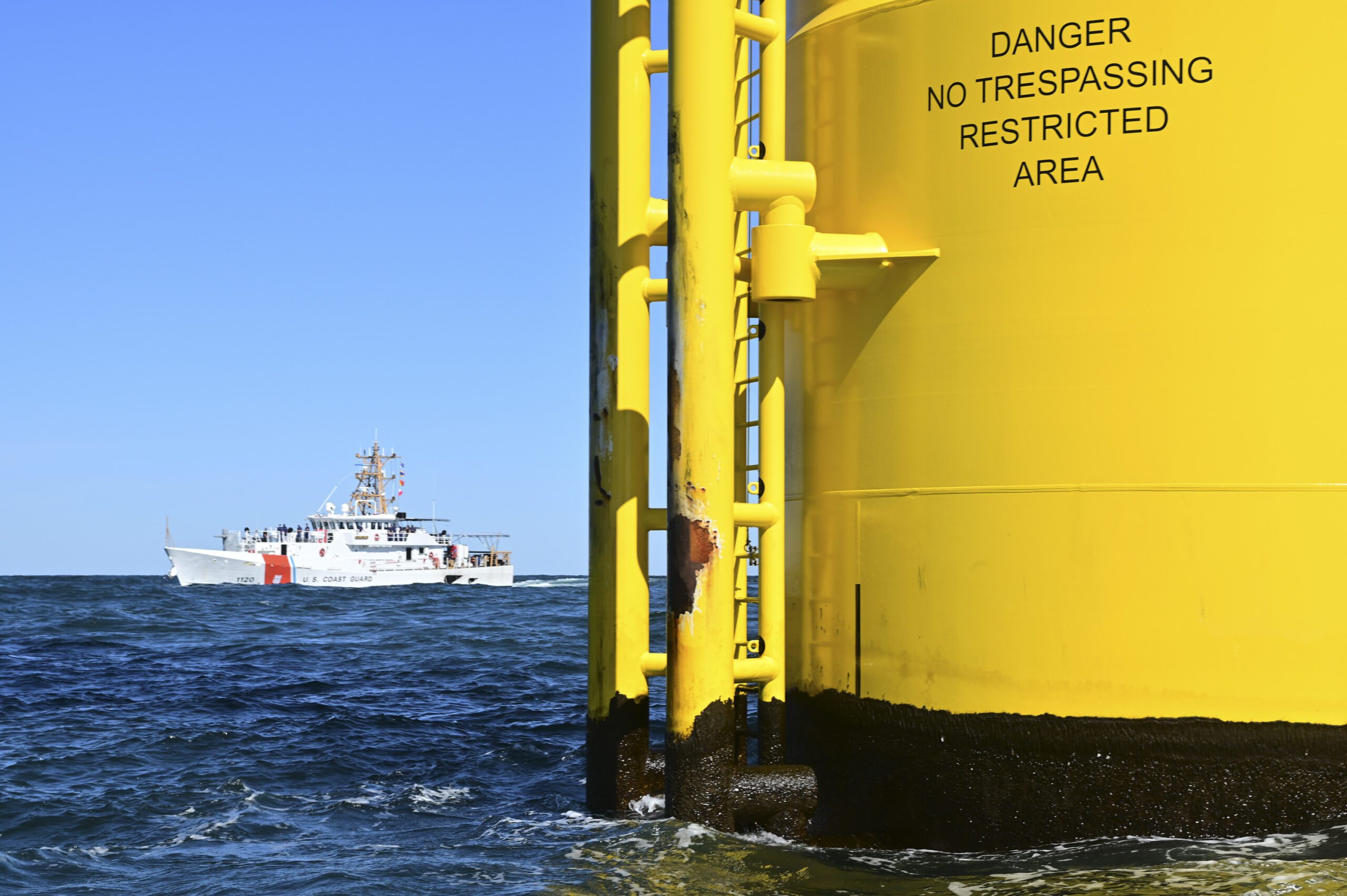By Jennifer A Dlouhy (Bloomberg) The US Navy and Pentagon are sounding alarms over Biden administration plans to advance offshore wind projects along the central Atlantic US coast, warning that almost all of the new terrain eyed for development conflicts with military operations.
Maps shared with industry stakeholders and seen by Bloomberg News show vast red areas that the Navy and Air Force have deemed “highly problematic,” covering prime real estate the Interior Department last year earmarked for leasing off the coasts of North Carolina, Virginia, Maryland and Delaware.
The Defense Department’s concerns, which come on top of other conflicts identified by the US Coast Guard, have spooked renewable power developers and US East Coast states counting on mid-Atlantic wind farms to meet clean energy and climate goals.
The breadth of the Pentagon’s opposition could imperil President Joe Biden’s bid to install 30 gigawatts of offshore wind power — equivalent to 30 nuclear reactors — by the end of the decade, newly bolstered state goals for the development and planned manufacturing facilities in Maryland and Virginia tied to the nascent US industry.
The clash represents the latest threat to the fledgling industry that is already grappling with supply chain challenges, inflation-stoked prices and opposition from coastal communities.
Representatives of the Defense Department did not immediately respond to requests for comment. Interior’s Bureau of Ocean Energy Management emphasized in an emailed statement that the US “is well positioned to satisfy state and federal offshore wind goals as we develop the clean energy economy.”
The Pentagon has identified challenges operating around wind turbines that would be installed into the seabed in Atlantic waters near many of its operations and facilities, including North Carolina’s Dare County bombing range, used for training fighter jet crews, and a weapons station in Yorktown, Virginia. They are documented vividly on a map of Navy and Air Force concerns, dated Oct. 6, 2022, and circulated with industry and state stakeholders this month.
Four of six potential wind lease areas outlined by the ocean energy bureau last November are completely shaded red, including two deep-water parcels that might require floating turbines. The remaining two tracts, in yellow, are identified as requiring further study. The areas deemed highest priority by the Pentagon span a large portion of potential lease areas off the Maryland and North Carolina coasts.
Similar Defense Department concerns helped derail plans for offshore oil leasing in waters near Virginia’s coast roughly a decade ago. And after the Pentagon warned the Interior Department against offshore wind leasing near the California coast in 2019, it took roughly three years to resolve the matter. The Interior Department had been on track to sell new offshore wind rights in the mid-Atlantic early next year — and significant delays could make it harder for developers to claim newly expanded tax credits for the multibillion-dollar ventures that can take years to permit and build.
The ocean energy bureau expressed confidence it could resolve the dispute. The agency “has a long working relationship” with the Defense Department “and together we have successfully deconflicted and identified areas that have resulted in 27 leases along the Atlantic coast, covering over 2.1 million acres,” it said in its statement. “We will continue this collaboration as we seek to identify new lease areas in the central Atlantic.”
When asked for comment, JC Sandberg, the American Clean Power Association’s chief advocacy officer, said that the industry is “fully committed to national security” and coexisting with other ocean users.
“Leasing in the central Atlantic is critical to growing the offshore wind industry to meet state and federal clean energy goals,” and to sustaining supply chain investments in the region, Sandberg said. “The Department of Defense staff’s maps serve as a stark reminder that there’s work to do. We need a coordinated, all-of-government approach to offshore wind to ensure that the industry can grow while protecting national security interests at the same time.”
The maps have inspired a frenzy of calls and meetings as alarmed offshore wind advocates ask top administration officials to referee the dispute and broker a compromise. Just last week, Maryland lawmakers passed legislation setting a state goal to derive 8.5 gigawatts of power from offshore wind by 2031 — but under the Pentagon’s vision, the state could struggle to find roughly half of that.
Already, most of Maryland’s congressional delegation had implored the Defense Department, Coast Guard and other government agencies to “maximize the acreage available for offshore wind development in the central Atlantic” and work to expand the potential areas for leasing.
Robust offshore wind leasing along the US mid-Atlantic is seen as essential to filling a pipeline of projects that can support planned investments in manufacturing facilities in the region, including the planned Sparrows Point Steel factory near Baltimore.
Supporters argue the work is also critical to hitting the nation’s climate targets. Because of its massive scale and high generating capacity, offshore wind is viewed as a particularly important source of renewable power.
And now, offshore wind advocates are throwing the military’s own warnings back at the Pentagon. A shift to renewable power sources helps shrink US reliance on volatile commodities for energy, thereby strengthening national security, they say. The Defense Department and US intelligence agencies also have repeatedly cast climate change as a threat to American military assets and global security.
“Offshore wind can enhance national security,” Sandberg said, “by providing a clean and affordable source of energy protected from the whims of global commodity prices.”
By Jennifer A Dlouhy © 2023 Bloomberg L.P.

 Join The Club
Join The Club











